Coronavirus (COVID-19): modelling the epidemic (Issue No. 31)
Latest findings in modelling the COVID-19 epidemic in Scotland, both in terms of the spread of the disease through the population (epidemiological modelling) and of the demands it will place on the system, for example in terms of health care requirement
Coronavirus (COVID-19): modelling the epidemic in Scotland (Issue No. 31)
Background
This is a report on the Scottish Government modelling of the spread and level of Covid-19. This updates the previous publication on modelling of Covid-19 in Scotland published on 10 December 2020. The estimates in this document help the Scottish Government, the health service and the wider public sector plan and put in place what is needed to keep us safe and treat people who have the virus.
This edition of the research findings also looks back over the period of the epidemic from February 2020 to the present time.
Key Points
- The reproduction rate R in Scotland is currently estimated as being between 0.9 and 1.1.
- The number of new daily infections for Scotland is estimated as being between 49 and 144, per 100,000 people.
- The growth rate for Scotland is estimated as being between - 2% and 2%.
- Modelling shows the peak week in the first wave for the spread of Covid-19 was 16 - 22 March with an estimated number of 145,000 people becoming infected. This was followed by a first wave peak in hospital occupancy (1,520) that occurred on 19 April, and ICU occupancy (208) on 12 April.
- Modelling shows the peak week in the second wave for the spread of Covid-19 was 4 - 10 October with an estimated number of 40,900 people becoming infected. This was followed by a second wave peak in hospital occupancy (1,264) that occurred on 3 November and ICU occupancy (111) on 8 November[1].
- Modelled rates per 100K indicate that by the week of 27 December – 2 January, 19 (up 7 from last week) local authorities have at least a 75% probability of exceeding 50 cases, 8 (up 6) of those have at least a 75% probability of exceeding 100 cases, and none of those has at least a 75% probability of exceeding 300 (or 500) cases. Overall, this is a deterioration compared to last week.
Overview of Scottish Government Modelling
Epidemiology is the study of how diseases spread within populations. One way we do this is using our best understanding of the way the infection is passed on and how it affects people who catch it to create mathematical simulations. Because people who catch Covid-19 have a relatively long period in which they can pass it on to others before they begin to have symptoms, and the majority of people infected with the virus will experience mild symptoms, this "epidemiological modelling" provides insights into the epidemic that cannot easily be measured through testing e.g. of those with symptoms, as it estimates the total number of new daily infections and infectious people, including those who are asymptomatic or have mild symptoms.
Modelling also allows us to make short-term forecasts of what may happen with a degree of uncertainty. These can be used in health care and other planning. The modelling in this research findings is undertaken using different types of data which going forward aims to both model the progress of the epidemic in Scotland and provide early indications of where any changes are taking place.
Modelling outputs are provided here on the current epidemic in Scotland as a whole, based on a range of methods. Because it takes a little over three weeks on average for a person who catches Covid-19 to show symptoms, become sick, and either die or recover, there is a time lag in what our model can tell us about any re-emergence of the epidemic and where in Scotland this might occur. However modelling of Covid deaths is an important measure of where Scotland lies in its epidemic as a whole. In addition, the modelling groups which feed into the SAGE consensus use a range of other data along with deaths in their estimates of R and the growth rate. These outputs are provided in this research findings. The type of data used in each model to estimate R is highlighted in Figure 3.
A short term forecast and projection of the number of cases, ICU and hospital bed demand is also provided at this stage of the epidemic in Scotland.
The year so far
The virus has appeared in two waves: the first stretched from February up to the beginning of July, and the second began at the end of summer. At this point in time, we estimate that the second wave has not reached the incidence levels demonstrated in the first wave, but the upcoming festive period and new year means that we may not yet have seen the full peak of this wave.
Current medium term modelling, accounting for a recent uptick in cases and predicted festive period and new year pressures, suggests a new peak is possible, somewhat above the October peak. However, there is a wide range of uncertainty, e.g. in terms of people's behaviour, so this might not occur.
Time series of the R number
SAGE produces a weekly estimated consensus of the range of the R number for Scotland which modelling from the Scottish Government contributes towards. This began in late May and the series can be seen in Figure 1. In the thirty-one weekly consensus, there have been 16 weeks where the R number was less than or equal to one indicating a reduction in transmission of infection. This occurred for the consensus provided on 22 May to 5 August and 18 November to 9 December. There were seven weeks when the consensus estimated range spanned one, between 13 August and 2 September, 4 - 11 November and 16 December. During the eight weekly estimates for the period 9 September and 28 October, R was greater than one, resulting in exponential growth in infections.
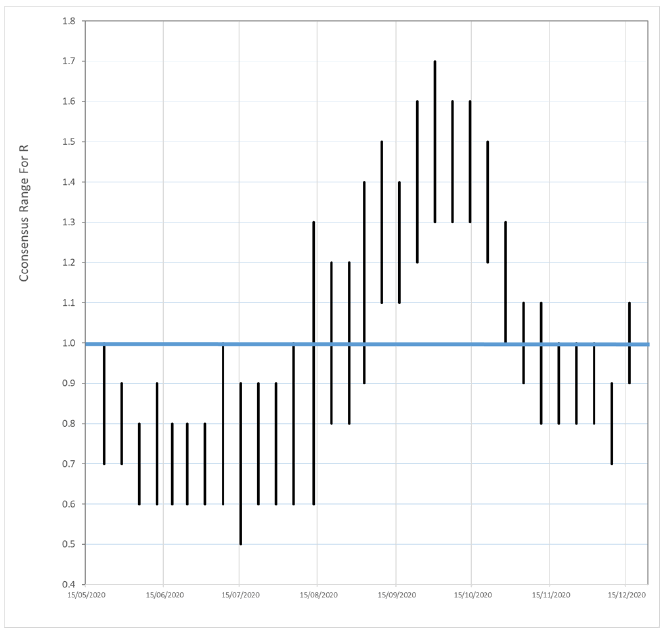
Overview of Wave 1
Current modelling, based on deaths, suggests that the first infections in Scotland took place around 16 February, and by the time that the first confirmed case was positively identified on 28 February, between 1,300 and 2,100 people had already been infected in Scotland.
The estimated peak week for the spread of the infection in wave 1 is 16-22 March with an estimated number of between 120,000 and 175,000 people becoming infected. The lowest estimated point in the epidemic was between 20 and 26 July where between 220 and 360 were infected.
Since the first modelled infections in February until 26 July the epidemic had lasted some 23 weeks, during which an estimated total of between 480,000 and 700,000 people had been infected with Covid in Scotland – between 8.8% and 12.8% of the population. This modelling derived estimate forms part of the picture on the number of people who had Covid in Scotland during wave 1.
These estimates vary from those reported in issue 10 in this series[2] as a result of additional data, and changes to the model such as additional covariates as a result of interventions, and improvements in treatment reducing mortality. These alterations modify the historical assessment of the epidemic.
Overview of Wave 2
Following the summer period where the level of infections was at its lowest level since late-February, we have seen infection levels rise into a second wave.
The estimated peak week so far for the spread of the infection in wave 2 is currently 4 to 10 October with between 34,000 and 50,500 people becoming infected. The peak in hospital occupancy (1,264) occurred on 3 November and ICU occupancy (111) on 8 November.
The forecast deaths from the model closely followed the trends seen in real data (Figure 2), however the model has until very recently been forecasting less deaths than the actual number recorded by National Records of Scotland.
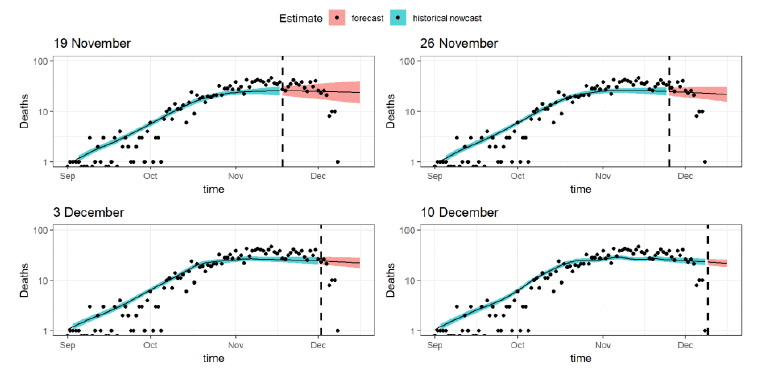
However, currently levels of infection show no clear signs of abating. Although estimated infections per week are lower than they were at the peak, some 40% of the total infections having occurred in the twenty weeks since the infection low-point with a small upturn in recent weeks, which could indicate that the last two months have experience more of a plateau than the downturn following the crest.
We currently estimate around 4 million people in Scotland have not yet been infected with Coronavirus – the majority of the population. This is why measures such as local protection levels, as set out within Scottish Government Advice and Guidance are so critical to maintain, particularly as we approach the festive period and the new year, when there is likely to be increased household mixing, people are likely to be inside more, and light levels and temperature are lower. It is also why continuing to model the epidemic, and continually improving how we do this, is a crucial part of how we monitor our progress and what might happen next.
What the modelling tells us about the epidemic this week
The various groups which report to the Scientific Pandemic Influenza Group on Modelling (SPI-M) use different sources of data in their models (i.e. deaths, hospital admissions, cases) so their estimates of R are also based on these different methods. SAGE's consensus view across these methods, as of 16 December, was that the value of Rt in Scotland was between 0.9 and 1.1. This is the first time the R range has straddled 1 since 11 November. The R value estimated by the Scottish Government is very slightly higher than the consensus range (Figure 3).
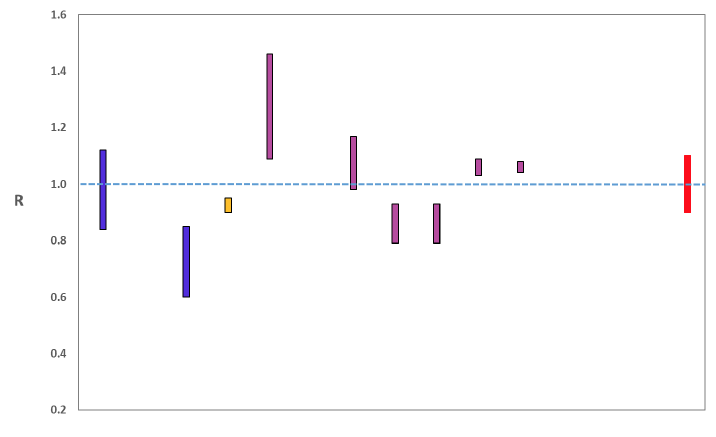
Source: Scientific Advisory Group for Emergencies (SAGE).
The various groups which report to the Scientific Pandemic Influenza Group on Modelling (SPI-M) use different sources of data in their models to produce estimates of incidence (Figure 4). SPI-M's consensus view across these methods, as of 16 December, was that the incidence of new daily infections in Scotland was between 49 and 144 new infections per 100,000. This equates to between 2,700 and 7,900 people becoming infected each day in Scotland.
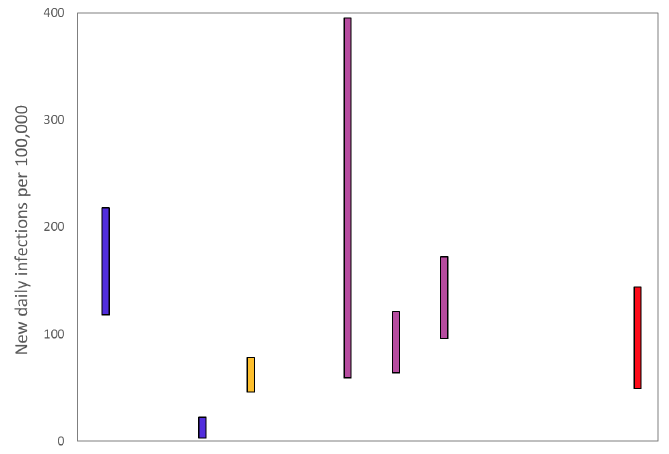
Source: Scientific Pandemic Influenza Group on Modelling (SPI-M).
The consensus from SAGE for this week is that the growth rate in Scotland is between -2 and 2% per day. Last week the growth rate was in the range -5% and -2%.
The logistical model developed by Scottish Government to assess implications for health care demand (see previous Research Findings) has been adapted to produce a short/medium-term prediction of infections.
Figure 5 shows a projection that assumes the Rt value is above 1, and will rise further as areas move out of Level 4 restrictions.
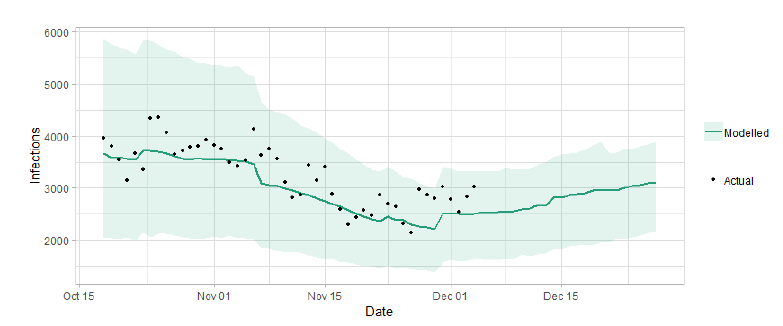
What the modelling tells us about Hospital bed and ICU bed demand
Figure 6 shows the impact of the projection on the number of people in hospital.
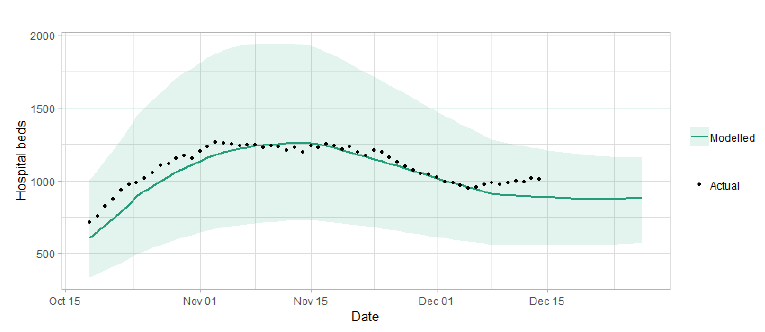
Figure 7 shows the impact of the projection on ICU bed demand.
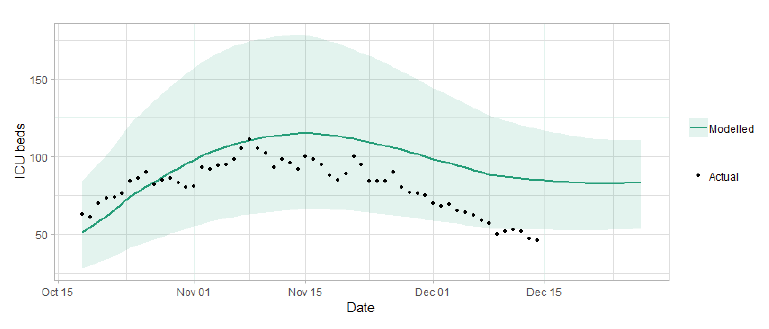
What the modelling tells us about projections of hospitalisations in the medium term
SAGE produce projections of the epidemic[3] (Figure 8), combining estimates from several independent models (including the Scottish Government Government's logistics modelling, as shown in figures 5, 6 and 7). These projections are not forecasts or predictions. They represent a scenario in which the trajectory of the epidemic continues to follow current trends and do not account for the impact of future policy or behaviour changes. Nor do they include seasonal effects that might increase transmission.
The delay between infection, developing symptoms, hospitalisation and death means the projections cannot fully reflect changes in transmission that might have occurred over the past two to three weeks.
Beyond two weeks, the projections become more uncertain with greater variability between individual models. This reflects the large differences that can result from fitting models to different data streams, and the influence of small deviations in estimated growth rates and current incidence.
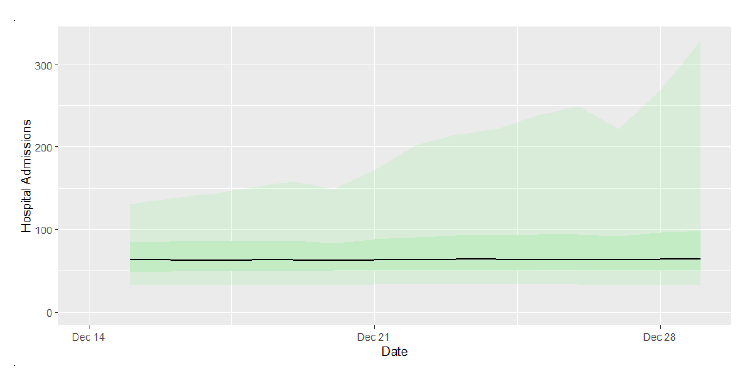
What the modelling tells us about what could happen during the festive period and in the New Year
There is a degree of certainty up until the start of the festive bubble and beyond this point, uncertainty increases (see Figure 9). The New Year will likely see a return to contact patterns from before the festive period, with schools reopening and university students returning. There is a significant risk that the festive period mixing will lead to seeding of the virus in parts of the population that were previously less affected, like individual workplaces, or areas of the country.
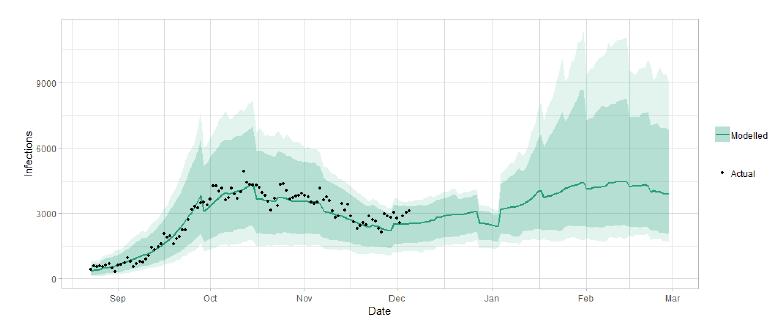
It is likely this would lead to a short-term uptick in transmission (Figure 9). The longer term consequences depend on the strength of the non-pharmaceutical interventions in place in these newly seeded areas. This is accounted for through a large range in assumed transmission values. Figure 10 shows the impact of this projection curve on numbers of hospital inpatients. The festive period is likely to see an increase due to the increased contacts for older people and people from at-risk groups.
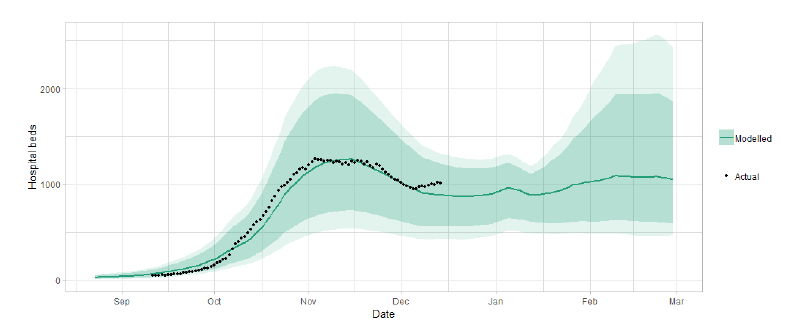
What we know about which regions are experiencing high levels of Covid
We use modelling based on Covid cases and deaths[4], conducted by Imperial College London, to give us an indication of whether a local authority is experiencing high levels of Covid. An area is defined as a hotspot if the two week prediction of cases (positive tests) per 100K population are predicted to exceed a threshold, e.g. 500 cases. See technical annex in issue 24.
Modelled rates per 100K (Figure 11) indicate that by the week of 27 December 20 – 2 January 21, 19 (up 7 in the last week) local authorities have at least a 75% probability of exceeding 50 cases, 8 (up 6) of those have at least a 75% probability of exceeding 100 cases, and none of those have at least a 75% probability of exceeding 300 (or 500) cases.
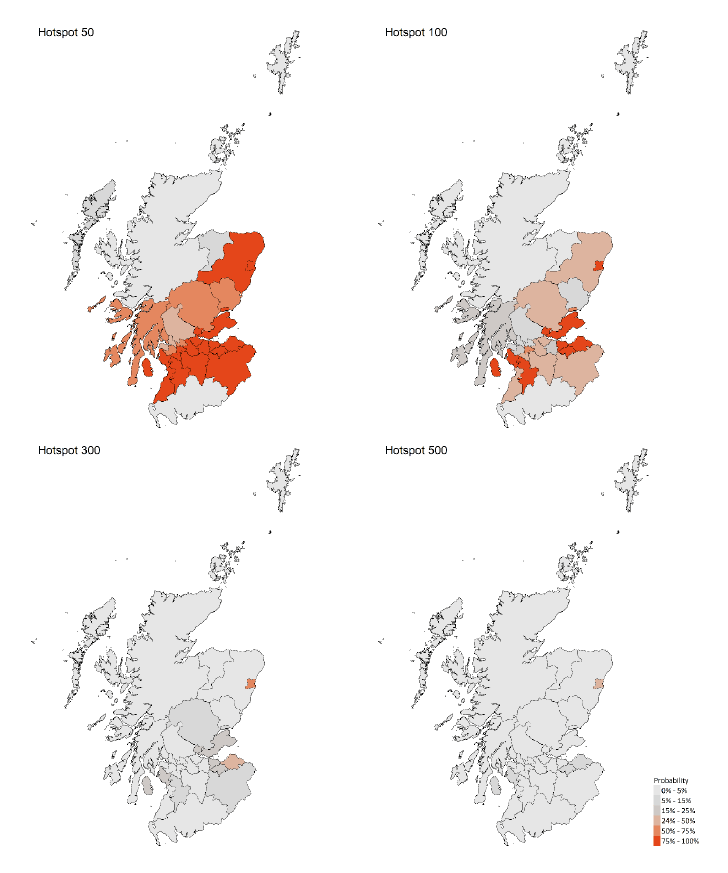
What next?
The Scottish Government continues to work with a number of academic modelling groups to develop other estimates of the epidemic in Scotland.
The modelled estimates of the numbers of new cases and infectious people will continue to be provided as measures of the epidemic as a whole, along with measures of the current point in the epidemic such as exceedance. Rt and growth rate will also be provided for the next publication, this will be on Wednesday 23 December. Further information can be found at https://www.gov.scot/coronavirus-covid-19.
We continue to track the analysis by SEPA of the reported levels of Covid-19 in wastewater samples. We will report on this when there are new findings.
Contact
There is a problem
Thanks for your feedback